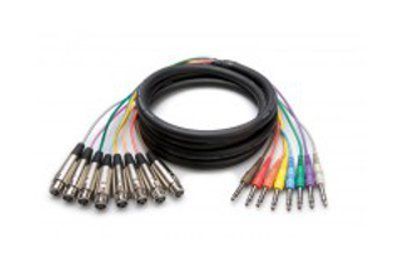Hosa Balanced Snake Cable - 8 Channel - XLR Female to 1/4' Stereo Male
Hosa Balanced Snake Cables - 7M XLR Female to 1/4' Stereo Male Cable
Snake cables are commonly used to combine multiple cables into one smaller diameter cable, making setup and teardown faster. This 8 channel snake cable features fully molded ¼ IN TRS male connectors opposite 3 pin XLR female connectors. The flexible PVC jacket prevents cable kinking and helps prevent damage to the connectors. Internally this cable is fully shielded to protect against RFI/EMI interface. Our snake cables are perfect for novice and professional musicians.
Features:
- Side A: 8 x ¼ IN TRS Male
- Side B: 8 x 3 pin XLR Female
- Number of audio channels: 8
- Balanced
- Fully shielded
- Nickel plated connectors
- Molded strain relief
- Connects balanced line outputs to balanced line inputs
- RoHS compliant
Q: What is a snake cable?
A: A snake cable is a cable that contains 4 to 32 separate audio channels inside the same cable jacket. Snake cables are commonly used whenever multiple audio signals like microphones need to be sent to the same locations.
Q: What is a stage box?
A: A stage box is a rugged metal housing that is used to connect microphones and other audio devices to a snake cable. If acts as an extension that allows the sound desk to be moved further away from the stage.
Q: What does TS mean? What is a TS connector used for?
A: TS is the abbreviation for “Tip Sleeve IN and refers to a specific type of 1/4″ connector that is set up for 2-conductor unbalanced operation. One insulator ring separates the tip and sleeve. The tip is generally considered the “hot IN or the carrier of the signal while the sleeve is where the ground or shield is connected. TS cables are best known as guitar or line-level instrument cables.
Q: What does TRS mean? What is a TRS connector used for?
A: TRS is the abbreviation for “Tip Ring Sleeve. IN It looks like a standard 1/4″ plug but with an extra “ring IN on its shaft. TRS cables have two conductors plus a ground (shield). TRS connectors are commonly used to connect balanced equipment or for running both left and right mono signals to stereo headphones.
Q: Why is a ¼ IN connector sometimes called a “phone plug IN?
A: The original 1⁄4 in (6.35 mm) version dates from 1878 when it was used for manual telephone exchanges making it possibly the oldest electrical connector standard still in use. It was used for years by telephone operators to patch telephone connections together.
Q: What are XLR Cables commonly used for?
A: XLR Connectors are commonly used for professional audio video and stage lighting equipment.
Q: What is a balanced cable and what makes them different then an unbalanced cable?
A: Balanced refers to a “three-legged IN type of electrical signal that has two legs independent of ground. One is generally considered positive and the other negative in voltage and current flow with respect to ground. Both legs carry the signal. The benefit is that any noise that gets induced into the line will be common to both the positive and negative sides and is thus canceled when it arrives at its destination assuming the destination is balanced. Balanced lines are generally best for long cable runs due to their ability to reject induced noises. XLR and TRS type cables are designed to transmit balanced audio from one balanced device to another.
Unbalanced cables are less complicated and less expensive but they have limitations. Any audio signal requires two wires or conductors to function. In an unbalanced cable situation one of those conductors is used to carry both the audio signal and ground (shield). Unbalanced cables are much more susceptible to induced noise problems than their balanced counterparts because any induced noise in one conductor is not canceled by similar noise in the other conductor and may be carried with the signal into connected equipment. In general unbalanced lines should be kept as short as possible to minimize potential noise problems.
| Features & Specs | ||
|---|---|---|
| Connector Side A | Connectors on this cable?? | 8 x ¼ IN TRS Male |
| Connector Side B | Connectors on this cable? | 8 x 3 pin XLR Female |
| Length | The Length of the cable? | 2 Meter |
| Number of Audio Channels | Number of audio channels this cable will support? | 8 |
| Use | The use for this cable?? | Audio |
| Shielding | The type of shielding?? | Fully shielded |

